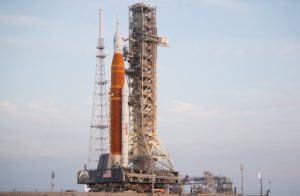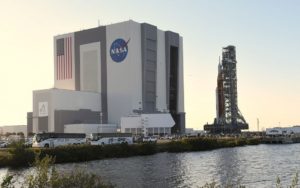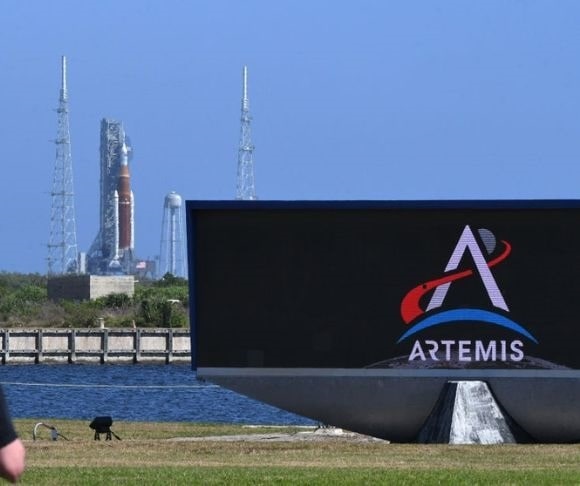The National Aeronautics and Space Administration (NASA) is returning to the moon after a half-century of manned space missions that ventured no further than the international space station. On Dec. 14, 1972, the Apollo 17 Mission Commander Gene Cernan, Lunar Module Pilot Harrison Schmitt, and Command Module Pilot Ronald Evans commenced their return trip to earth, the curtain closing on US manned lunar exploration. On Aug. 29, NASA plans to raise that curtain with the launch of its new Space Launch System (SLS) rocket, carrying the first of three Artemis program missions to the moon and return.
The Artemis spacecraft consists of the SLS that uses a main or core stage booster with four RS-25 liquid-fueled rocket engines, two solid rocket boosters on either side of the core stage, an Interim Cryogenic Propulsion Stage (ICPS), and the Orion Multi-Purpose Crew Vehicle sitting atop the stack. On the launch pad, the SLS at 322 feet is taller than a football field is long. The R-25 solid rocket boosters are the same reliable ones used on myriad space shuttle missions. By comparison, the SLS’ lifting capability is 8.8 million pounds, or 15% more thrust than the Saturn V, rated at 7.7 million pounds, the first stage that propelled the Apollo missions to the moon.
The improved SLS will produce 9.9 million pounds of thrust and is envisioned to carry humans into deep space. Artemis 1 is the first step for the US space program. “This is a mission that truly will do what hasn’t been done and learn what isn’t known. It will blaze a trail that people will follow on the next Orion flight, pushing the edges of the envelope to prepare for that mission,” Mike Sarafin, Artemis 1 mission manager, explained to an audience at NASA Headquarters in Washington, DC.
NASA Returns to the Moon Exploiting Existing Technology

Image Credit NASA Joel Kowsky
The ICPS rocket located just behind the Orion crew capsule will propel Artemis 1 and eventually a crew from an initial earth orbit toward insertion into a lunar orbit. The ICPS is a modification of the Boeing Company’s existing liquid oxygen/liquid hydrogen-based second-stage rocket engine powering the United Launch Alliance’s Delta IV rockets, demonstrating again NASA’s desire to “not reinvent the wheel.” The first mission will not carry a crew and is designed to test the suitability of both the SLS and the Orion space capsule to successfully fly to, orbit, and eventually land on the moon. The Artemis 1 mission profile includes the 280,000-mile trip from liftoff at Kennedy Space Center to the moon, much like the Apollo program. But on the way, Artemis 1 will do something unique to previous moon missions. The ICPS will separate from the Orion spacecraft and release ten small satellites, roughly 4 X 4 X 4 inches, into space on its way to a lunar orbit, and the ICPS will be disposed into deep space. The satellites — called Cubesats — will take up their discrete tracks to the moon to perform various experiments and demonstrations.
Artemis Moon Mission Will Be Unique
Meanwhile, the Orion craft will make a low flyby of roughly 60 miles above the moon’s surface and then move to a position nearly 40,000 miles beyond the moon, taking up what NASA calls a distant retrograde orbit (DRO). Orion will make a half or one and a half DROs before returning to earth. Depending on the number, the length of the Artemis mission will be 26-42 days. Artemis’ tasks are ambitious by any standard, more so if one considers the spacecraft’s 3,200 parts and subassembly suppliers, all flying in close formation.

(Photo by Paul Hennessy/Anadolu Agency via Getty Images)
Other aspects of the Artemis 1 mission are unique. Instead of the venerable visage of Walter Cronkite providing the play-by-play and color commentary for an Apollo launch, NASA has gone for more entertainment value. “It will be quite an event, and not just for the die-hard space fans,” Mike Wall, writing for Space.com, reported. Additionally, the live broadcast of the launch and festivities available to the anticipated crowd will be “a special performance of ‘The Star-Spangled Banner’ by Josh Groban and Herbie Hancock. It also will feature a performance of ‘America the Beautiful’ by The Philadelphia Orchestra and cellist Yo-Yo Ma, conducted by Yannick Nézet-Séguin,” NASA announced.
Cut through the glitz, and the Artemis lunar program is remarkable for its technological breakthroughs and, most of all, for taking mankind back to the moon. The truth is, that most Americans don’t care about the scientific information and technical data that robotic space missions accumulate. But put a live astronaut in a futuristic spacesuit on the moon – and all imaginations are captivated.
The views expressed are those of the author and not of any other affiliation.




